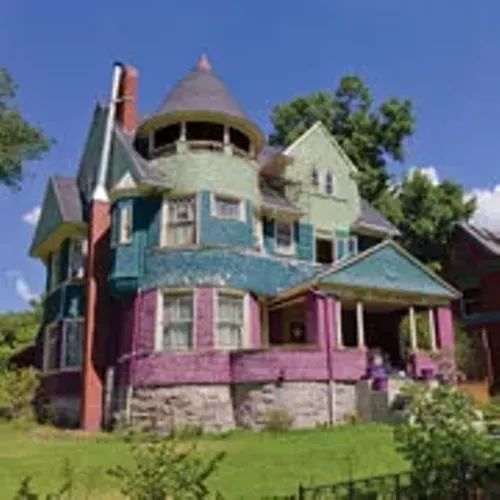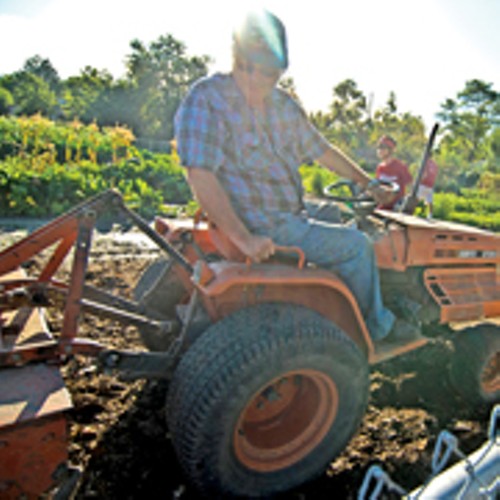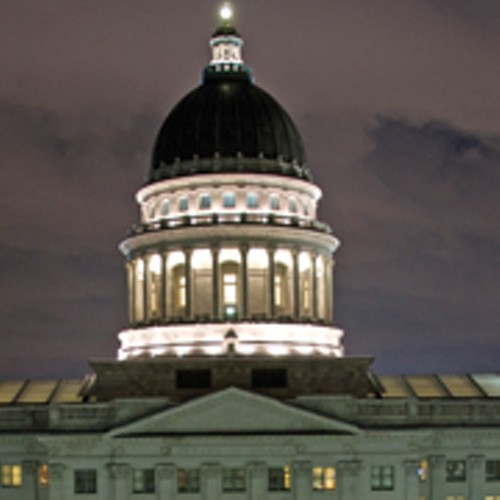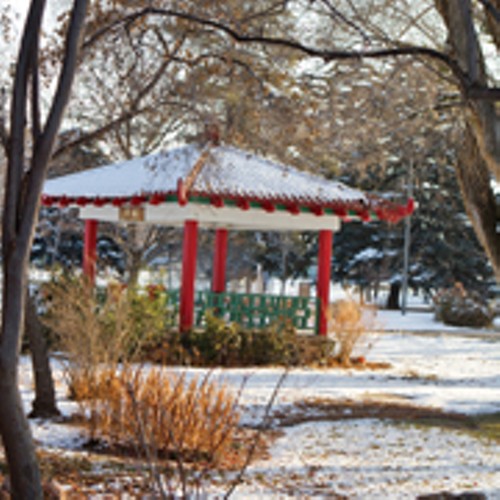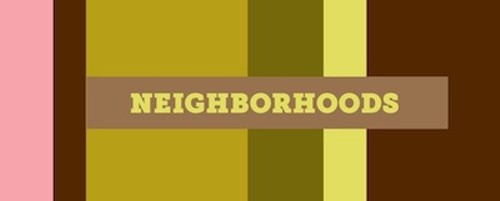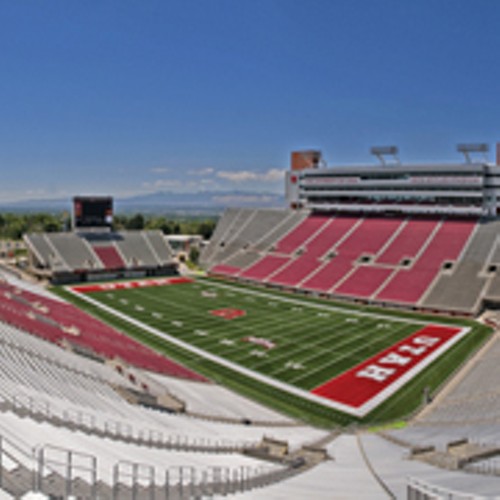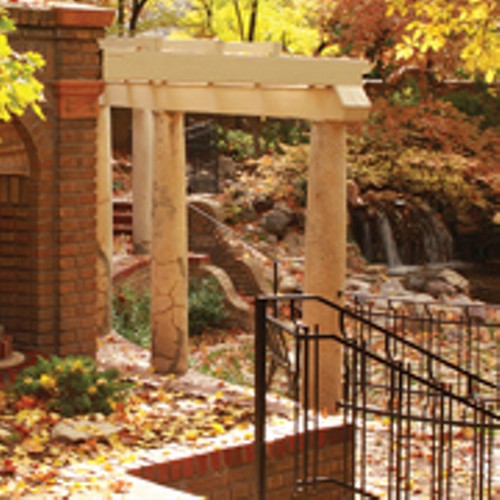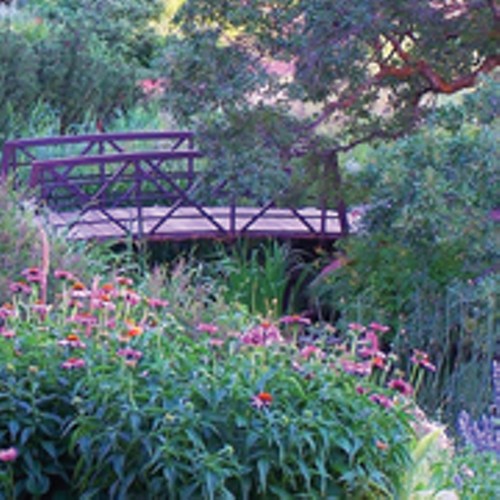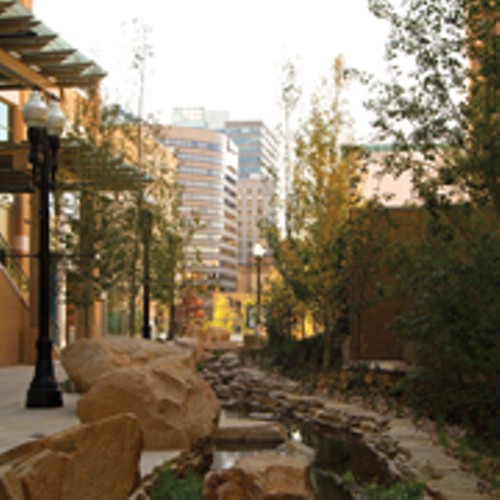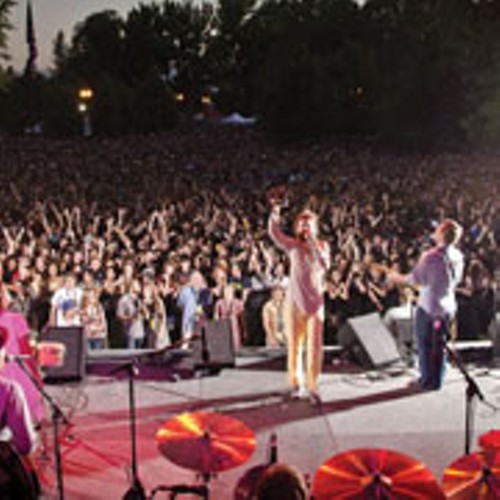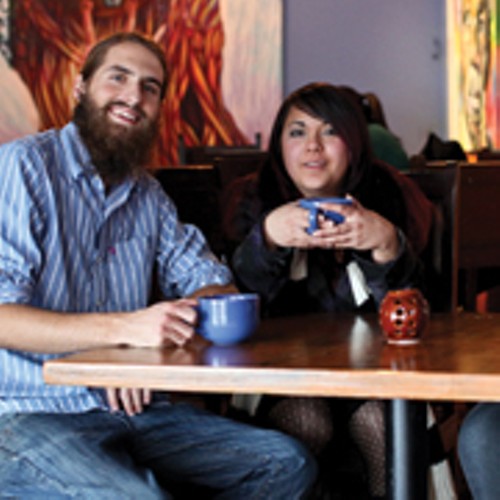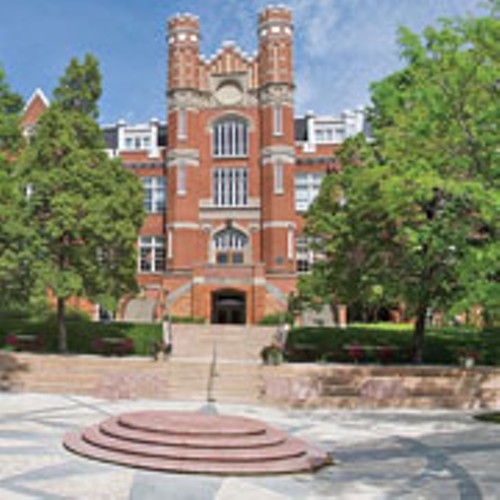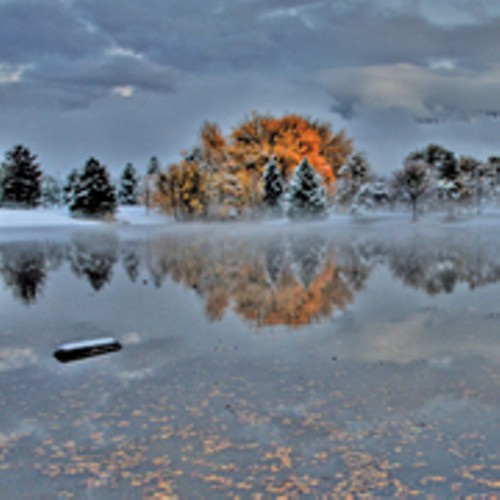Most folks who live in Salt Lake City proper are privy to a secret, which is: They live in a place that offers the vitality, accommodations and attractions of a big city—without the hassles.
The 186,000 strong who call Salt Lake City home make up a little patch of liberal "blue" in a conservative "red" state. The up-and-coming, the "arrived," the hipsters, the "cultural creatives," the urban farmers, the 99 percent/protest-minded and assorted crotchety characters—all can easily find a place to call home and to fit in.
Whether you live in a high-rise condo, a traditional apartment, a warehouse loft or a rehabbed historic bungalow, there's no shortage of appeal in terms of residential options. Combine home sweet home with the city's vibrant theater, film, dining, concert and club offerings, and you'll find you're luxuriating in Utah's sweet spot. Shhh, don't tell anyone.
With a downtown ready to rise up and shock the hell out of everyone (by that we mean the new City Creek Center, opening March 2012), a rapid-transit rail system that is the envy of many cities in the West, and cottages on fruit-tree-lined streets where xeriscaping and chicken coops are all the rage, one thing shines through: Salt Lake City is a surprisingly cool place to live or visit. Check out the various 'hoods and let them reveal their charms.
To get your bearings, remember the city is organized along a grid system. Most streets run north to south and east to west, emanating from Temple Square, home to the LDS Salt Lake Temple. Many addresses are coordinates on the grid, for example: 250 East 900 South. That means the actual place you are looking for is located between 200 and 300 East on the street called 900 South. And just to really keep you on your toes, a few streets have retained standard street names, such as State, Main and Broadway. Once you get used to them, the coordinates really do help.
The Avenues
If you're visiting—or better, if you're a Utahn—exploring South Temple is a must. Starting with the iconic LDS Temple followed by the Cathedral of the Madeleine then by the First Presbyterian Church, then by stately mansions and fraternal houses (Kearns Mansion, the Beehive House and Major Downey Mansion are a few), South Temple seems like a microcosm of religious denominations in America. Once you get past the handshakes and free scriptures, however, you'll realize that much of the population living here is a far stretch from the stereotypical Sunday-morning pew-sitters. Demographics in the Avenues (aka the Aves) are well-mixed, relative to neighboring neighborhoods, but, as a rule, WASPishness and wealth increases with each foot gained in altitude.
In the lower Aves, expect to see pedestrians walking their furry companions, sipping lattes and sucking down freshly ground wheatgrass shots. Their environmentally conscious neighbor will cruise by on his gently used mountain bike, and all is good in this 'hood. Dave Van Langeveld, the chair of the Greater Avenues Community Council, says, "There's such a nice mix of young and old, families with children, professional people and blue-collar laborers. [The variety] really enhances the whole area." And, Langeveld points out, the neighbors tend to work together to better their community despite their differences. Look for the vibrantly renovated Memory Grove Park for great views of the Utah Capitol and even a meditation chapel.
The upper echelon of the Greater Avenues community ascends from 11th Avenue and Virginia Street onward. Here, you'll find McMansions (built before the zoning regulations forbade an extra two stories) neighbored by humble view-seeking bungalows made popular in the 1930s. Aside from a few tennis courts and parked Range Rovers, landscapers and lawn-care crews provide the only signs of life on weekdays.
The Avenues: North of South Temple, extending to city limits; east of State Street, extending to city limits
Rose Park
For those looking for a "real yard" at a "real price," Rose Park's fecund soil provides. Over the past decade, this neighborhood has received much-needed TLC—and almost any longtime resident will tell you that it's paid off. One of the largest city investments is the Jordan River Parkway, which has effectively [re]married Rose Park with the rest of Salt Lake City.
Rose Park has certainly had its bouquet of weeds, with a reputation for gang and drug activity, but now you'll find a community blogging about the best perennial flowers, Rose Park Revival meetings and art classes open to the public. In fact, this budding community gets its name from the rose-like layout of the streets. From above, the tree-lined streets form the outline of several roses, with American Beauty Drive acting as the stem (be imaginative). Many of these street petals reflect the gusto of post-World War II, when much of the neighborhood was developed to accommodate returning vets and their families: big yards with room to grow, and Frank Lloyd Wright's name imprinted on most classic homes. As Salt Lake City's up-and-coming neighborhood (not to mention its highly affordable living and close proximity to downtown), it's no surprise that locals and newcomers are planting roots in this fertile community.
Rose Park: West of Interstate 15 to Redwood Road; north of 600 North, extending to city limits
Capitol Hill
Residents of Capitol Hill, one of the city's oldest neighborhoods, boast of homes with diverse architectural styles that line the steep, curved streets. Here you can see an array of Pride flags and assorted "granola" banners waving in the breeze, kitty-corner to the 19th Ward Chapel, now occupied by the Salt Lake Acting Company, with a funky onion dome inspired by Russian immigrants. Let's not forget the neighborhood's namesake icon, which sits commandingly on the hill, mid-neighborhood. In fact, the Salt Lake City location for Utah's grandiose Capitol was lawmakers' second choice. After trekking to then-state capital Millard in Fillmore County during the harsh winter of 1855, they proposed relocating the state's capital to Salt Lake City. However, federal funding was denied because a "centrally located" capital already existed. It wasn't until the 5 percent inheritance tax was imposed upon railroad magnate Edward Henry Harriman's estate that Utah officials were able to begin planning for the Salt Lake City building, which became one of the prettiest and most intricately designed capitols in the nation. Recently remodeled and retrofitted for earthquakes, the building offers killer views of the valley in addition to irritating liquor legislation.
Capitol Hill: West of State Street to 500 West; north of South Temple, extending to city limits
Glendale
The quintessential "west-side story" of Salt Lake City, Glendale is among the city's most ethnically diverse neighborhoods. With its concentration of immigrant populations, street encounters will include a few "hellos," as well as "¡hola!," and a slew of greetings in other languages. The neighborhood is seen as Salt Lake City's cultural crossroads, hosting treasures like the International Peace Gardens and locally owned markets catering to the Spanish-speaking population. Housing costs are comparable to other west-side neighborhoods and, with visionary projects like the Glendale Library, neighbors are becoming more and more community-minded. This story is destined for a happy conclusion.
Glendale: West of Interstate 15, extending to city limits; south of 950 South to 2100 South
Poplar Grove
Often confused with its neighbors Glendale and Rose Park, Poplar Grove is directly south of the Salt Lake International Airport. "There's a misconception about west Salt Lake," says Andrew Johnston, chairman of the Poplar Grove Community Council. "It is lower socio-economically [than the east side], but there are a lot of great schools with great kids, a strong working class and healthy families in the area." The Spanish influence is definitely recognizable, and the locally owned markets and storefronts catering to the Spanish-speaking population set this neighborhood apart, along with the low cost of living. As a neighborhood community, residents are imbued with a sense of renovation and gentrification. Most are dedicated to making their community a livable, sustainable one with open lines of communication and connectivity throughout the neighborhood. In fact, the new 9 Line, modeled after New York City's High Line, is all about connectivity. With a bicycle path and walkways planned for pedestrians, this trail will follow 900 South, connecting the east and west communities and ultimately creating a stage for a diverse sampling of what Salt Lake City can offer.
Poplar Grove: West of Interstate 15, extending to city limits; south of North Temple to 950 South
Marmalade District
Marmalade is a neighborhood you'll want to drive Grandma around when she comes for a visit. With more than 100 years of existence, Marmalade's rich history can be found in the layout, architecture and even in Warm Springs Park, located near the former Children's Museum of Utah. When walking through this 'hood, most neighbors are friendly, and there's plenty to take in.
Marmalade is home to one of the largest LGBTQ communities in the Mountain West and was dubbed Salt Lake City's "gayborhood" in the early 2000s. The Gay & Lesbian Community Center of Utah (also known as the Utah Stonewall Center) has been here since its inception in 1991.
Despite technically existing as a sub-neighborhood of Capitol Hill, which towers above on a nearby slope, this neighborhood's unique flair earned itself 'hood status because of its funky, fabulously diverse residents and residences. The Marmalade District was named after the imported apricot and pear trees planted at the beginning of the 20th century. Remnants of these orchards can be seen everywhere from the historic parks to the street names: Apricot, Almond and Quince are just a few you'll want to frolic through. Plus, this lively neighborhood is near some equally lively nightlife.
Marmalade District: North of 300 North to 500 North; east of Quince Street to Center Street
Federal Heights & the University
With its proximity to the University of Utah campus, it comes as no surprise that the majority of sidewalk traffic is comprised of retired professors and university employees. If you stop any tenured neighbor, you'll soon realize that the grandeur of living so close to the exceptionally thriving college campus made up of more than 31,000 enrolled students soon wears off. The contentious relationships between homeowners who live near campus and the University's Greek organizations have been documented in the news. In the past decade or so, those relationships have been mending, according to retired professor Gene Fitzgerald, whose Prairie-style bungalow abuts the campus. "There are some people who have been here a long time, some just moved in, but everyone really gets along very well," he said. In addition to exploring a 1,600-acre hillside campus, look for reminders of the 2002 Winter Olympics. The university hosted the Olympic Village as well as the opening and closing ceremonies. The Olympic Cauldron Park, adjacent to Rice-Eccles Stadium, includes the distinctive Hoberman Arch.
Federal Heights: East of Virginia Street to the University of Utah; south of 100 South to Federal Heights Drive
Harvard-Yale & Yalecrest
No city is complete without its very own Ivy League area. And, as expected, residents (after chatting up the weather over a light-bodied Beaujolais) will likely pay tribute to their impeccable tree line. As one of the more sought-after areas in Salt Lake City, expect home prices to be higher than counterparts on the west side. This neighborhood is highly desirable for good reason: Not only are the streets quiet and quaint, but there are well-kept parks and great schools. Harvard-Yale has lately been the battleground for the private-property kings/McMansion developers versus homeowners fighting to maintain the historic look and feel of the neighborhood. Roger Little of the local community council says, "There's a really strong desire for outreach and inclusion. People love to be neighbors in this neighborhood. … There is lots of activity across fences and discussions in [Miller Park, located at 1500 East and Bonneview Drive] because parks provide a place for people to communicate." For this neighborhood, parks also prove to be a place of gathering—look for block parties in the summer.
Yalecrest: East of 1300 East to 1500 East; south of Sunnyside Avenue (800 South) to 1300 South
9th & 9th
Salt Lake City's very own mini-city is tight-knit, up-and-coming and a slew of other hyphenated adjectives describing its not-quite-hipster nature. Expect to see the city's 20- and 30-somethings and their beautifully groomed pets sipping lattes and shopping at one-of-a-kind boutiques. Technically, the intersection is located in the small neighborhood called East Liberty Park, but "9th & 9th" is catchy, right? Thirty years ago, locals described this neighborhood as "scrappy and dangerous." Now, the thriving and highly desirable 900 East and 900 South area serves as a NeighborWorks success story. In fact, the hyper-focus on promoting local businesses and assembling a lively community has inspired a counterpart on the west side: 900 West and 900 South. If you're around for the street festival, have a ball, but consider a quick walk through the surrounding streets. Take in the subtle competitive nature of each garden against the one adjacent, but most of all, enjoy the serendipitous feeling that everything seems to have fallen in exactly the right place.
9th & 9th: East of 800 East to 1100 East; south of 800 South to 1300 South
Foothill Drive, Wasatch Hollows, Bonneville & East Bench
The Well-Trodden Hills might be a more fitting description of these neighborhoods. Here, among the exotic animals in Utah's Hogle Zoo, This Is the Place Heritage Park, fabulous trails (some reaching as far as Emigration Canyon), the newly revamped Natural History Museum of Utah and the beloved Red Butte Garden, you'll find, as many Foothillians say, "culture with altitude."
Is exclusivity your favorite word? It might be if you lived here. The valley views from the East Bench are breathtaking to be sure, but you might not have many places to take them in. Those damned gates surrounding various mansion-filled neighborhoods make sure of that.
Foothill and East Bench: East of 1300 East to city limits; south of 500 South to Interstate 89
15th & 15th
Another hotspot neighborhood, 15th & 15th weaves together an independent bookstore, ethnic eateries, an art gallery and several fab boutiques. You'll find nearby blocks dripping with all that is quaint in the world. The eateries and shops define much of the area and seem to have had plenty of influence on the neighborhood itself. "We have what city planners want for every neighborhood," says District 5 Councilwoman Jill Remington Love, "open space, pocket parks, incredible local businesses, but most of all, great people who want to build community and look for solutions."
15th & 15th: 1500 East between Kensington Avenue (1530 South) and Emerson Avenue (1490 South)
Downtown
In recent memory, downtown has been a vacant part of town, home to nomads and their animal pals. But changes are brewing. Over the past two years, downtown Salt Lake City has seen a large increase in new businesses and activity. Oh, sure, you'll find hipsters who label themselves hipsters with a sprinkling of hotshot professionals but, for the most part, residents living downtown are looking to bring back the urbanity that SL,UT once had.
And, with plans for the expensive City Creek Creek to open in 2012, now seems to be the time for movement. Major retailers and delicious eateries will occupy the three blocks comprising City Creek—all of which will be connected by pedestrian-friendly walkways and residential condominiums. Christian Harrison, chairman of the Downtown Community Council, describes a certain hopeful vibe in the longtime residents and also those just moving in. "Now, most of the social interactions residents have are through events: friends at a gallery stroll, or neighbors at the farmers market. It's just really great to have a community to look forward to."
Downtown: West of State Street to 300 West; north of South Temple to 700 South
Central City West, Pioneer Park, The Gateway
Many longtime residents once associated this area with homelessness and suspicious activity, but with the storefront and residential developments spurred by TRAX and FrontRunner developments, Central City West, along with The Gateway shopping district, are fast becoming more chic urban areas. Close to downtown businesses and with lower housing costs, many who live here are able to walk to work. The area is anchored by EnergySolutions Arena, home to the Utah Jazz NBA team.
Pioneer Park, a historic park that once provided camping space for the city's arriving pioneers, is overcoming a modern-day image problem due to its proximity to homeless shelters. Thanks to an effort by city officials and downtown organizations, the park now hosts multiple community gatherings, including the fabulous Downtown Farmers Market and the summer's free Twilight Concert Series, bringing people from all over the Salt Lake Valley. Even the city's Occupy Movement first took root in Pioneer Park, illustrating the heartfelt connection between social movement and Pioneer Park.
Central City West: West of 300 West to Interstate 15; north of South Temple to 1300 South
Fairpark/North Temple
Just west of 300 West and near North Temple you'll find Fairpark—a community first perceived split by the freeway, but now, after working closely with NeighborWorks, building solidarity among residents. This merging of sections is visible in an art form beneath the overpass at 300 North and Interstate 15; "Bridges Over Barriers" is one of the nicest murals in the city. Community Council member Gordon Storrs agrees, saying, "We want to strengthen our ability to be a community through neighbor-to-neighbor caring. We're as good as anywhere else now, but I think we can do better." Despite some of the negative effects of the construction of the new TRAX line (to the airport—we're all counting down until 2013), businesses like the mainstays Red Iguana and Mestizo Coffeehouse are hanging on. Almost all local business owners and residents agree that once this TRAX line is open, it is sure to bring more foot traffic along with the planned light-rail schedule.
Fairpark: West of 500 West to 1460 West; north of North Temple to 600 North
Central City & Liberty Wells
West of the commercial and colloquial center of Sugar House is lively Liberty Wells and the "Sugar Hood." With less of the hustle and bustle of Sugar House, neighbors here seem to just get along. They range from first-time homeowners to old timers, but the differences in age don't hinder the friendly atmosphere. One thing they all agree on is how great it is to be within a stone's throw of Liberty Park. Second in size to Sugar House Park, Liberty has a vast array of amenities including a reinforced running and biking trail, tennis courts, an outdoor swimming pool, playgrounds, pavilions, an amusement park, boating and the beloved Tracy Aviary. And nearby Trolley Square is home to shopping and a giant Whole Foods.
Central City & Liberty Wells: East of State Street to 700 East; south of South Temple to 2100 South
Sugar House
The sugar mill after which the neighborhood was named never materialized, but Sugar House remains one of Salt Lake City's sweetest communities. Nestled in the armpits of the Interstate 80 corridor, Sugar House has one of the largest and loudest community councils in Salt Lake City. With great nightlife, free parking, local shops and big-box stores, numerous festivals and tasty eats, there's a lot to talk about. It's a big area, too. Neighbors here range from young to old, rich to poor, college students, ski bums and exercising geeks. The character of the neighborhood is enhanced by Salt Lake City's renowned private liberal-arts Westminster College. And, coming soon is a $55 million Sugar House Street Car that will link Highland Drive and other residential communities to the main TRAX line.
Many of the residents here pride themselves on Sugar House's historical significance. The state's first penitentiary, for instance, was located where the park and Highland High School now stand. Also, Sugar House Park is always buzzing with activity and, as the city's largest park, serves as a treasured landmark for residents. Tradition seems to be valued here—after budget cuts left this park fireworks-less, money was donated to keep the program going and lighting up the skies on the Fourth of July.
Sugar House: East of 700 East to Foothill Drive; north of 1700 South to city limits
This guide highlights the distinctive hoods of Salt Lake City proper. Bear in mind that south of Salt Lake City are another 14 cities, one town and six townships that comprise the rest of Salt Lake County. The million-plus residents of the county and the more than 2.5 million who live along the Wasatch Front have their own reasons for visiting Salt Lake City, if only to take in a Jazz game downtown, see a world-class ballet, eat a tasty Crown Burger, or a visit the elephants at the zoo.
Speaking of ,
-
Walk of Shame, The Lego Movie
New DVD/VOD Tuesday, June 17
- Jun 16, 2014
-
Drinking-Class Zero
Following a night of drinking, Wendy Simpson, 25, walked to a McDonald’s restaurant in West Yorkshire, England, where she was told that the counter was closed and only the drive-through was open but that she couldn’t be served
- Jun 16, 2014
-
How to Train Your Dragon 2
Dragon 2 shows DreamWorks is still willing to be daring
- Jun 13, 2014
- More »
More by Beth Clifford
-
SLC Chopped
5 Chefs, 4 Mystery Ingredients, 1 Kitchen
- Oct 12, 2011
-
App Happy
Download these apps to enhance your scholarship.
- Aug 18, 2011
-
Required Reading
Some books help you pass a midterm, others get you through life.
- Aug 18, 2011
- More »
Latest in City Guide
Readers also liked…
-
City Guide 2023
City Weekly’s 19th annual celebration of all things SLC
- May 4, 2023



